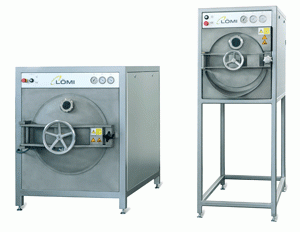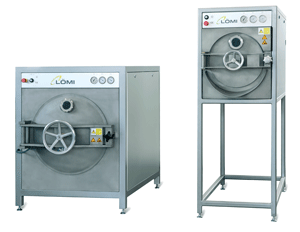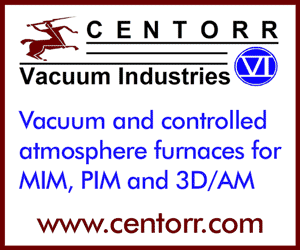LÖMI: New developments in solvent and water debinding systems for MIM and CIM
November 2, 2013
Germany’s LÖMI GmbH is widely recognised as a market leader in the production of explosion-proof solvent debinding furnaces for PIM and the company has for many years worked in close cooperation with feedstock and part manufacturers to continuously improve its technology. As water debinding becomes more important for PIM producers, the company reports on the latest innovations in its range of debinding systems for the industry.
Located close to Frankfurt, in the centre of Germany, LÖMI GmbH was established in 1991 as a manufacturer of solvent recovery systems. From the start the company has had a strong research and development focus and many of its systems were developed through research initiatives with project partners such as Fraunhofer-Gesellschaft and a number of renowned German universities.
In 2001 the company added solvent debinding furnaces to its manufacturing portfolio and over a period of just a few years established itself as a market leader in this area. Now, with over twenty years of experience in explosion-proof technology for handling flammable solvents, LÖMI offers a range of debinding furnaces for the PIM industry. Customers include some of the leading MIM/CIM manufacturers worldwide, including those that supply the automotive, aerospace and medical sectors.
Today the company offers three different types of debinding furnaces; one for organic solvent soluble binder systems, one for water soluble binder systems and one unique furnace type which is capable of debinding with both organic solvents and water in one single system.
Solvent debinding systems
Commenting on the advantages that the organic solvent debinding process has over other processes, Christian Ferreira Marques, Managing Partner at LÖMI, told Powder Injection Moulding International, “The first advantage is that MIM/CIM part producers are free in their choice of feedstock, as numerous kinds of feedstock systems can be processed via the solvent debinding process. This makes it easy for part producers to test new feedstocks, or to add another feedstock producer as a supplier, without having to invest in a new debinding furnace. In addition, solvent debinding furnaces offer a very long lifetime as the solvent debinding process causes very little wear and tear.”
LÖMI’s debinding furnaces can use various organic solvents, including acetone, ethanol, hexane, heptane and trichloroethylene (TCE). “The solvent debinding furnaces always come with a solvent recovery system which provides a fresh debinding medium at all times. The solvent recovery rate of the system is up to 99%, making our debinding furnaces very economical and environmentally beneficial,” added Marques. The solvent is operated within a closed loop and, together with the debinding furnace being explosion-proof, this ensures a safe work environment.
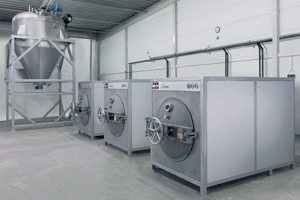
Fig. 2 Three solvent debinding furnaces EBA-900
with a parallel solvent recovery system MDA-3000
shortly before commissioning at a major Indian
customer
The company’s solvent debinding furnaces are available with capacities from 50 litres to 2,500 litres. “For small numbers of injection moulded parts, our EDA series of furnaces combine debinding, vacuum drying and solvent recovery in one single unit. For medium and large numbers of MIM/CIM parts, our systems consist of two units, an EBA series debinding furnace with a capacity of up to 2,500 litres and a parallel solvent recovery system matched to the customer’s process. Should a part producer later wish to expand its production capacities, all LÖMI systems can be extended on a modular basis,” stated Marques.
Water debinding systems
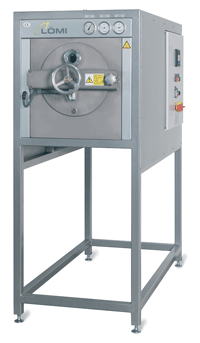
Fig. 3 Water debinding furnace
EBA-50W: a front-end loader
with automatic process and
integrated drying of parts
Water debinding has to-date primarily been used by CIM part producers. LÖMI’s José M Dias Fonseca stated, “In the past some producers used large open water baths to immerse their green parts. After the debinding process, the watery brown parts had to be removed from these baths and transported and loaded into a drying oven. This often caused damage to the brown parts, in addition to the increased time span and costs for the extra handling step. We addressed these problems two years ago by developing our EBA-W series water debinding furnace. These furnaces are designed as ergonomic front-end loaders, making it very easy to load and unload MIM and CIM parts.”
In addition, these systems feature the integrated drying of parts so that the brown parts can remain within the furnace after the debinding process. Programmable logic control (PLC) ensures an automatic process once the parts are loaded.
The latest research and development in water debinding
“In recent years a number of MIM and CIM part producers have tried to optimise their water debinding processes only to find that this technique places much higher demands on the performance and quality of water debinding equipment than many anticipated. To address these issues and further improve our water debinding furnaces, we have undertaken extensive research and development in recent months, in close cooperation with some renowned MIM/CIM part producers,” continued Dias Fonseca.
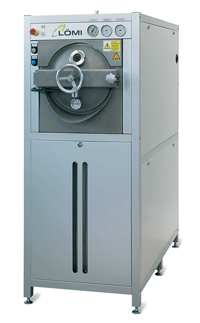
Fig. 4 Rental system EDA-50LW
for debinding with organic solvents
or water in one single furnace
for testing new feedstocks or
optimising processes
“To debind green parts containing a water soluble binder system, part producers often use acidic demineralised water. This type of water, along with certain additives and inhibitors which the feedstock producers require the part producers to add to the debinding water, has been shown to be capable of corroding even stainless steel. As a result, this demands increased requirements for the materials and components of a water debinding furnace. This holds true for the material of the process chamber, which no longer can be an ordinary stainless steel, as well as for the materials used in the pumps, hoses, sensors and actuators. All welded seams also needed to be reviewed and the welding process modified where applicable. All the surfaces with direct contact to water vapour have to be reappraised and, where needed, their materials replaced. In addition, when water is used to debind metal parts from a MIM process, this often leads to corrosion of the parts themselves. This has to be prevented with suitable measures.”
As a result of its research, LÖMI undertook a complete review of its water debinding furnaces and the company’s engineers are currently implementing solutions to the challenges identified. In addition, with regards to the drying process, it became evident that vacuum drying alone was not sufficient. Water bubbles could form on the loading trays and these made the green parts move, sometimes even making them stick together. As a solution, the company has developed and installed a specific new drying technology.
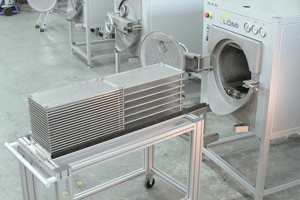
Fig. 5 Mobile loading aids allow easy transportation
and preparation of the next batch of parts
while the current batch is still in the furnace
“For manufacturers of medical devices and luxury goods, a major problem was the fact that superfine particles accumulated on the surfaces of brown parts during the water debinding process. Sometimes smear marks due to additives in the debinding water could be found on the brown parts after the debinding process. We have solved these problems by developing and implementing a specifically modified debinding process,” stated Dias Fonseca.
To facilitate the water debinding process for its customers, LÖMI has embedded sensors into its equipment that monitor various parameters of the utilised water and show them on a display in real time. For a higher-quality process (debinding and drying), a temperature control was installed that can reach up to ten target values over a certain time period. This feature is particularly important for water debinding processes but can also be installed in solvent debinding furnaces.
Solvent and water debinding in one system – for testing and diversifying
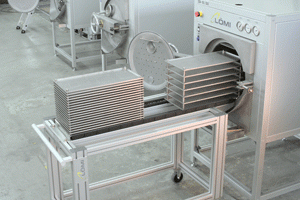
Fig. 6 Easy single handed and time saving
loading and unloading of debinding furnaces
using a loading aid with wear-free rollers
“In recent years many producers who operate conventional manufacturing processes for metal or ceramic parts have learned about PIM technology. Some of these producers are still reluctant to enter into PIM production and wish to test it first. Likewise, producers that already use PIM technology are looking to diversify their processes or test new feedstocks,” stated Ralf Wegemann, LÖMI’s Marketing Director.
To meet this demand, the company has developed a furnace capable of debinding with both organic solvents and water in one system, the first of its kind in the industry. The system, EDA-50LW, is available as a rental system so that prospective PIM producers can test their processes in their own company. “Experienced PIM producers can try out new kinds of feedstock and/or binder systems or optimise their existing processes, using both organic solvents and water to debind their green parts. Should a PIM parts producer later decide to puchase a new debinding furnace, LÖMI will customise the furnace to the producer’s process, based on the test results,” continued Wegemann.
Common characteristics of all LÖMI debinding solutions
The engineers at LÖMI conduct their research and development in close cooperation with feedstock producers and MIM/CIM part manufacturers and as a result the company has gained a comprehensive understanding of the entire PIM technology process chain. This has led to the near continuous enhancement of the company’s debinding furnaces, improving both reliability and efficiency. The furnaces employ well proven technology and are fully customisable by means of a programmable logic control system. Even complex processes can be operated with a LÖMI debinding furnace, as the company develops tailor-made systems specific to customer requirements.
LÖMI is an accredited company according to the EU Water Framework Directive and its furnaces meet European directives for occupational health and safety, as well as environmental protection. An in-house accredited safety engineer will give prospective customers advice where needed.
The company’s furnaces feature a high-quality stainless steel design and an integrated drying of parts, which saves production time and costs, as no additional handling of the brown parts is required between debinding and drying. LÖMI’s debinding furnaces are ergonomically designed as front-end loaders with an optimal loading and operating height. To facilitate the operation of a system, remote diagnostics and maintenance are available, as well as a telephone service hotline.
“Our furnaces are cost-saving through their compact and energy-saving design, their low investment and a short lead time. Generally, one of our furnaces pays for itself within one or two years after commissioning. Rental systems are also available for prospective customers to test their debinding processes in-house in their own companies. The costs for the rental system can be credited to a purchase of a new debinding furnace,” stated Wegemann.
New features and new auxiliary equipment
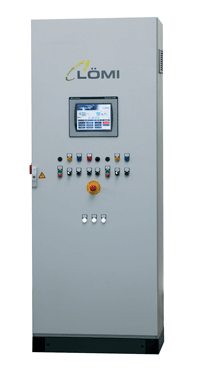
Fig. 7 The new large display in control
cabinet shows current states of various
process parameters in real time for
debinding, drying and solvent recovery
Many of the most recent improvements to the company’s debinding furnaces and their auxiliary equipment have been directed at making their operation more ergonomic and efficient, thus saving time and costs during the production of PIM parts. Wegemann stated, “As an example of some of these improvements, to facilitate the monitoring of the debinding, drying and solvent recovery processes for the operator, the current states of the various process parameters are now shown on the display in real time. Additionally, we have entirely revised the locking mechanism of the front-end sealing cover. A ratchet tensioner now enables the operator to increase the tightness of the equipment even during its operation, at the same time preventing him from accidentally opening the cover.”
“Also, the auxiliary equipment has been considerably improved and standardised. A large variety of trays and mobile loading aids are now available in order to save time and costs during the production process. While one batch is still inside the debinding furnace, the operator can prepare the next batch by placing the green parts on trays of different LÖMI-standardised sizes and heights, then stacking these trays onto a mobile loading aid. When the batch inside the debinding furnace has undergone the drying process, the operator can move an empty loading aid right in front of the opened front-end cover of the debinding furnace and slide the racks of trays with the brown parts easily out of the furnace onto the mobile loading aid. Prepared racks of trays with the new batch can then be slid into the furnace. This unloading and loading procedure now takes only a few moments, making switching batches between processes much more efficient and cost-saving.”
Until a few months ago, the loading mechanism used stationary mounted metal rails within the debinding chamber, and the metal racks with the green parts were slid onto these rails. This used to cause abrasive wear and small metal particles therefore ended up within the debinding chamber. As they impaired the quality of the surfaces of the brown parts, the company has completely revised the loading mechanism, which now utilises wear-free rollers. In addition, the components of the loading mechanism within the debinding chamber are now completely removable. This makes the cleaning of the debinding chamber significantly easier and the operator only needs one hand to remove the loading mechanism from a small furnace.
Contact
Diplom-Ingenieur (FH) José M Dias Fonseca and Diplom-Ingenieur (FH) Christian Ferreira Marques, Managing Partners
LÖMI GmbH
Am Gemeindegraben 10
63741 Aschaffenburg
Germany
Tel: +49 6021 447799 0
Fax: +49 6021 447799 30
Email: [email protected]
www.loemi.com
News | PDF Store | Magazine Subscriptions | What is PIM? | e-newsletter




